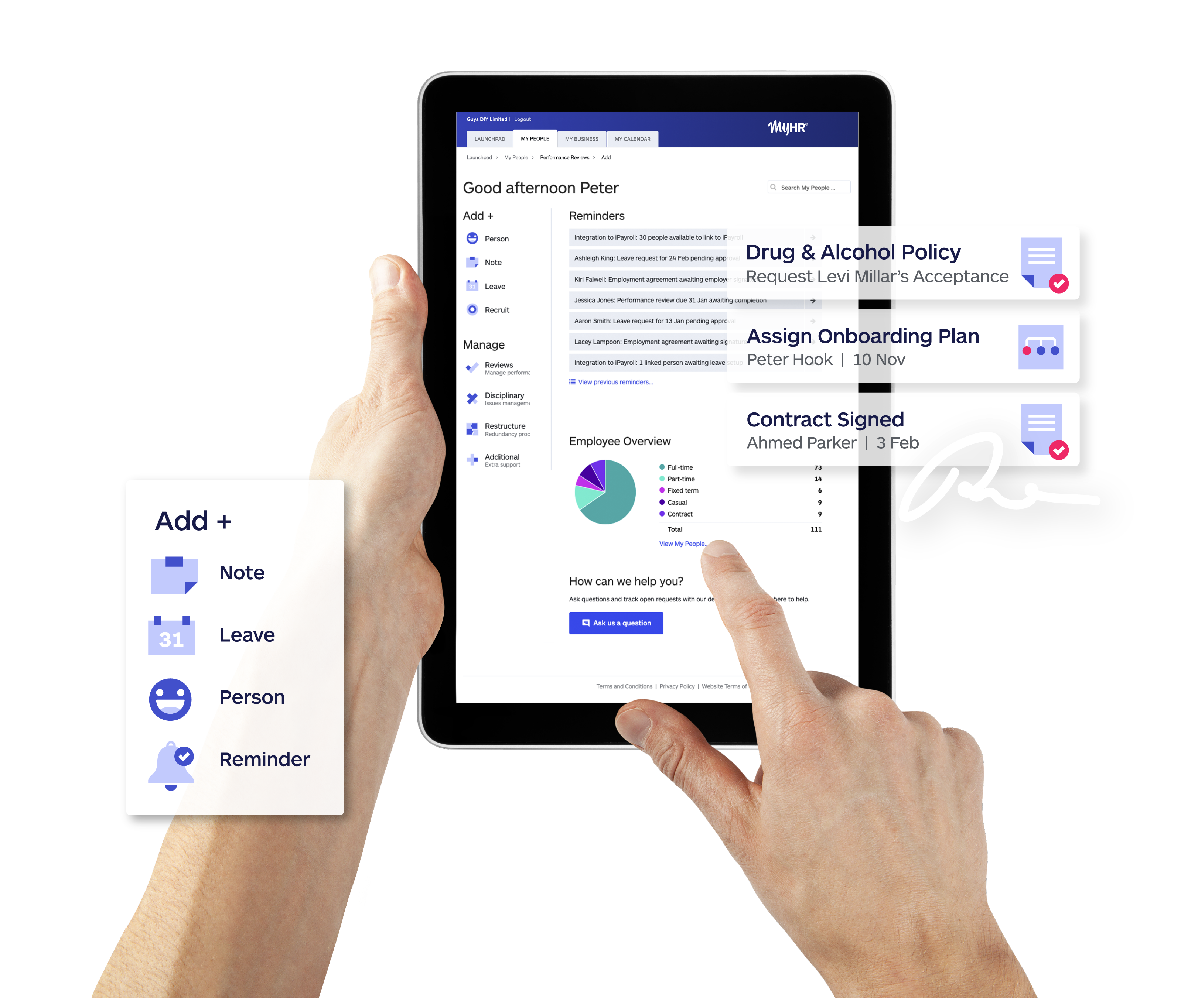
The disciplinary process is a formal tool for managing and correcting employee misconduct or unacceptable behaviour. It helps employers work through concerns with employees and give them the opportunity - and support - to change their behaviour.
You would usually take disciplinary action after an employee has failed to respond to less formal management techniques, such as feedback or counselling, but there may be times when you need to take an employee through the disciplinary process for a single instance of misconduct.
As an employer you need to have a valid reason for taking disciplinary action, follow fair process, and adhere to the provisions of the applicable modem award, enterprise bargaining agreement (if one exists), as well as the person’s employment contract and any company policies.
Responding to misconduct
Employee misconduct can harm workplace productivity and damage the employment relationship. Whether it’s caused by a clash of personalities, someone struggling with issues outside work, or a change in business focus that staff members aren’t comfortable with, you need to correctly identify the issue so you can address it with the right process.
Because a problem with poor performance will require a different response (i.e. performance management) than an issue with employee conduct.
Initially, you will probably take proactive steps to manage the situation and provide the person with a clear understanding of what acceptable behaviour is, but if these don’t produce the desired results, you will need to step up your efforts.
The disciplinary process holds people accountable for their workplace behaviour and sends the right message to the rest of your employees that poor behaviour isn’t okay and that you want to work with people to change.
Engage in the right process
Discussing a behaviour concern with your employee may seem unnecessary. Surely, if there is an obvious problem, then you should just issue them with a warning and get on with it, right?
Not quite. Your efforts in engaging in the proper process to reach an outcome is really important, especially if you end up terminating the employment relationship. We cannot stress this enough!
You might have a perfectly legitimate reason to take action against an employee for unsatisfactory conduct but if you do not follow due process, your actions may be seen as harsh, unjust, and/or unreasonable - and therefore invalid. Employees have the ability to pursue a claim for either unlawful or unfair termination, and we recommend seeking advice before you consider taking this type of action.
Claims made against you can lead to compensation payments and legal bills, and you may have to withdraw or retract your decision to terminate, therefore re-instating the employment relationship.
Fairness in your process
The main reason the disciplinary process exists is to ensure employees are treated fairly and reasonably, and that you create an environment where you can obtain information so you can consider the facts and circumstances and make the right decision.
You must not predetermine the outcome. Any decision is not final until you have given the employee an opportunity to put forward their side of the story, and you have taken their views into account.
We use the term “allegations” to indicate that the misconduct is alleged until proven to have occurred.
Additionally, keep in mind that not all misconduct matters are equal - a process you undertake for an allegation of being late to work will differ somewhat from one you undertake for an allegation of theft or bullying.
We recommend you keep a chronology of events or a diary of what you know, who complained to you, what past conversations have taken place, and more.
You’ll now want to start to plan your process:
- Is this a misconduct you have become aware of yourself and want to address?
- Is it a complaint or formal grievance, e.g. from a co-worker or customer?
- Is this the employee’s first allegation or have you addressed something similar previously?
- Is this a serious allegation (e.g. gross misconduct) and you need to consider suspension of employment while you investigate?
- Do you need to notify anyone else of the allegations, e.g. senior leaders, the board, police for criminal allegations?
- Do you have additional people you need to meet with as part of your process, e.g. witnesses?
- Are you clear on what your next steps are and where you need to pause and change course as you gain more information??
Get the facts first
Before you make any decision on an outcome, you need to gather the facts or various points of view. If you are running a formal process you will need to ensure you:
- Give the employee notice for a formal meeting, at least 24 hours notice.
- Offer the employee the ability to bring a support person to the meeting (this can’t be a manager or senior leader of the company as this would be deemed as conflict of interest).
- Let them know who else is joining you for the meeting - we strongly recommend you have another person present (e.g. another leader or senior leader) to help you take notes and provide support.
- Set a location for the meeting that is private and appropriate. In some cases, being in the same room may not be possible and you would need to conduct the meeting through video call. You will need to be equally empathetic and respectful in either of those settings.
- Have scripts for the meeting invite, the meeting itself, and strategies for any possible challenges that might come your way.
How to present and respond to allegations
Depending on the nature of the allegations (remember running late is not the same as theft) you can choose one of two options during the formal meeting:
- Prepare what is called a “formal record of discussion” - a document outlining the allegations, referencing the policies breached by the allegations, and have a number of questions ready to be discussed in the meeting. The purpose here is to lead a discussion that you document then share a record with the employee asking them to review and confirm or add any further details within the next few days (minimum 48 hours).
OR - Prepare an allegation letter also outlining the allegations, the policies breached, and request a written response to the allegations by a certain date (also minimum of 48 hours).
In both instances it is important you remind the employee of:
- The confidentiality of the matter.
- Access to an Employee Assistance Program, if your company offers one.
- The ability to request an extension if they need further time for their response, e.g. they want to consult their legal advisor who is not available within the next 48 hours.
- Their ability to take time off work to prioritise working on their response if they wish to do so.
- Their ability to respond sooner and request an earlier meeting should they request it, e.g. they want the process over due to the stress it’s causing them.
- Whether you are considering dismissal and if they need to provide a response as to why their employment should not be terminated.
Follow-up meeting(s)
Your employee has now either reviewed the record of discussion or responded in writing to the allegation letter. They may request that you schedule a follow-up meeting for a further discussion of their response or to ask you questions before you make your final decision.
This is also a formal meeting that requires notice, option for a support person, and the right location. It is also a meeting that needs to be documented and the notes shared with all parties for their record.
Making a decision
You can now take a moment to decide the outcome of your process. You may want to close the matter quickly (especially if you feel the employee needs urgent closure), however, we recommend that you take the time to review all the evidence and points of view, then make a decision.
You also do not want to be perceived to have made a quick decision that didn’t properly take the employee’s response into consideration.
Outcome
You will now schedule an outcome meeting, which is also formal meeting (remember this means notice and support person)
Having run a formal process, you will need to document your outcome formally as well, we call this an outcome letter. The outcome letter is intended to:
- Summarise the allegations and the employee’s response.
- Confirm the final findings, i.e. were the allegations substantiated, partially substantiated, or unable to be substantiated?
- Outline what the outcome is: no further action taken, a warning, counselling or training, termination.
- Remind the employee about confidentiality and any support available to them.
Let’s take a closer look at the possible outcomes:
No further action
The allegations were not substantiated, unable to be substantiated, or the employee had a reasonable explanation for their behaviour.
Verbal warning
For good reasons, you may deem a verbal warning is the appropriate response and you decide to change from a formal to informal process. You should still capture this outcome in a letter to close out the process.
Formal written warning
Formal written warnings are for serious breaches of the terms and conditions of employment including company policies. Note you can issue a second or third warning for subsequent breaches before leading to termination.
First and final written warning
This explains that further instances of misconduct may result in the termination of employment.
Termination of employment
Termination is only an option in cases of proven gross misconduct, e.g. violence, theft, being intoxicated at work, or for misconduct that follows prior warnings.
Our post on termination will help ensure you follow the correct procedure.
Other outcomes
Additionally you can include further outcomes such as training, counselling, issuing an apology or the agreement of an action plan following the conclusion of the process.
A few points to remember
Sometimes, it may be unclear if you need to commence a disciplinary process for a performance issue, misconduct or both. It can get complicated if, for example, the misconduct is linked to a lack of training or performance concerns.
You can run two processes, i.e. deal with any misconduct then address performance separately through a performance improvement plan.
Be clear on who the decision-maker is for matters of this nature in your business. If you are a senior leader, you may need to consult and inform the CEO or the board on specific matters, and seek their support for the decision you are recommending.
Always involve key stakeholders in your decisions and avoid acting emotionally or alone. It is important that you have a trusted partner to guide and support you as these processes can take an emotional toll.
How MyHR can help
MyHR has helped thousands of businesses with disciplinary processes. Our expert advisory team provides scripts, documentation, and guidance to ensure you get the best result and minimise your legal risks. Our powerful HR platform makes managing documentation a breeze, whether it’s capturing and collating notes on employee conduct, or tracking and analysing your team’s performance.




